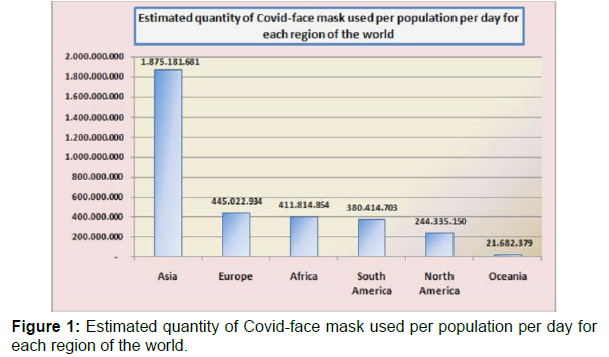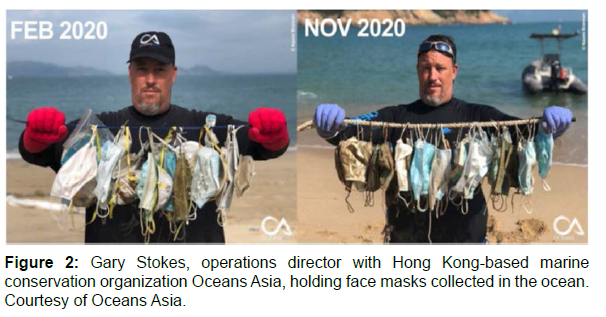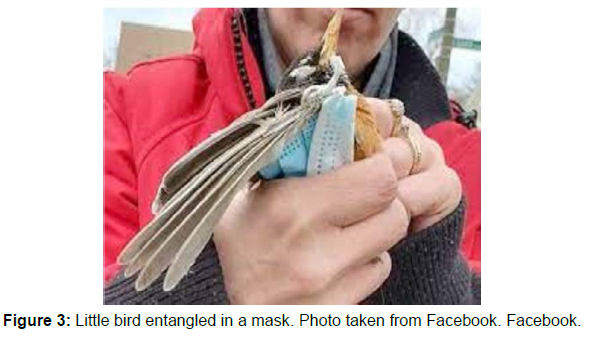Masks and Gloves: the New Pollutants
Received: 10-Mar-2022 / Manuscript No. EPCC-22-56817 / Editor assigned: 14-Mar-2022 / PreQC No. EPCC-22-56817(PQ) / Reviewed: 01-Apr-2022 / QC No. EPCC-22-56817 / Revised: 03-Apr-2022 / Manuscript No. EPCC-22-56817(R) / Accepted Date: 14-Mar-2022 / Published Date: 15-Apr-2022 DOI: 10.4172/2573-458X.1000268
Abstract
Pollution is one of leading cause of morbidity and mortality and was associated with approximately 9 million premature deaths globally in 2015, accounting for 16% of all deaths worldwide. Modern healthcare plays an important role in environmental pollution and in this context, for example, the healthcare sectors of the United States, Australia, England and Canada are estimated to emit 748 million tons of carbon dioxide equivalents per year. The dramatic increase in the use of personal protective equipment (PPE) during the COVID-19 pandemic is sure to worsen this scenario. Various environmental associations are involved in the collection of these waste materials and in the cleaning up of coasts and natural environments. However, even if disposed of properly, they either will go to landfill or be incinerated, further increasing global pollution. New ways to recycle PPE waste or to create biodegradable PPE in order to reduce its environmental impact are currently being studied. However, it is necessary to make people aware of the correct disposal of these devices. Just as people have shown themselves responsible in following the instructions of the government to contain the infection by staying at home, now they must prove equally responsible in the management of PPE that must be disposed of correctly and not dispersed in the environment.
Keywords: Personal protective equipment; Disposable masks and gloves; Covid-19; Pollution; Recycle; Biodegradable
Keywords
Personal protective equipment; Disposable masks and gloves; Covid-19; Pollution; Recycle; Biodegradable
Introduction
At the end of 2019, an alarming and severe infectious disease caused by a newly discovered coronavirus was first reported in China [1]. The rapid world-wide transmission of this virus, named COVID-19, resulted in declaration of a global health emergency by the World Health Organization (WHO) on 30 January 2020, calling for the adoption of restrictions on mobility. Within a year, COVID-19 infected more than 102 million of the world’s population and caused over two million deaths [2]. At the time, no one would have ever imagined that within a year the human kind would find itself as the protagonist of what a week before could have been just the plot of a science fiction movie. The Coronavirus has abruptly interrupted human common habits, made certainties tremble, and violently changed individual and social lifestyle. At the same time, it caused massive job losses and threatened the livelihoods of millions of people; as most Companies had to shut down to control the spread of the virus. Transportation systems were also shut down and flights cancelled. Everybody had to become familiar with terms such as lookdown, social distancing and gathering.
Covid 19 is mainly transmitted by air, through the droplets produced by the breath, speaking or coughing. In particular, larger and heavier droplets are involved in the transmission; they are carried by the air for short distances, generally no more than one meter and can settle on objects or surfaces which then become a spreading source of the virus. If someone touches a contaminated object with hands, they can act as an indirect transmission vehicle when passed over the mouth, eyes or nose. Therefore, hand washing is always the cornerstone of correct prevention.
In addition, to counteract the virus’s remarkable spreading capacity, people were forced to wear protective masks, gloves, and to use hand sanitizer as frequently as necessary. These obligations and recommendations have resulted in an impressive demand for personal protective equipment, with serious repercussions on the environment and climate. The increase in the production of disposable masks aimed to reduce the risk of infection has generated greenhouse gas emissions of between 14 and 33.5 tons of carbon dioxide equivalents per ton of product [3].
For instance, it is estimated that 65 billion gloves are globally used every month. The number of masks used is almost double: 129 billion per month, or about 3 million marks per minute. Considering that a surgical mask weighs approximately 3.5 g, this would correspond to 451,500 tons of masks per month which, placed side by side, would cover an area about three times the size of Singapore [4]. Several studies confirm the relevance of the problem. For example, the most populous nation in the world, China, throws away nearly 702 million facemasks a day. More generally, 1.8 billion masks are thrown away every day in Asia, the highest amount among continents, followed by Europe (445 millions), Africa (411 millions) Latin America (380 million), North America (244 million) and finally Oceania (22 million) [5] (Figure 1). Obviously, these numbers will increase exponentially due to the covid-19 protocols adopted by many countries that require the mandatory use of masks. They are all disposable devices, being cheap enough to be used once and then discarded. However, after the elimination, they do not fade away. Surgical masks typically consist of three elements: the protective part, the rubber bands and the metal bar to be tightened on the nose. The protective part consists in turn of an external layer of non-absorbent material (e.g. polyester), an intermediate layer of non-woven fabric (e.g. polypropylene and polystyrene) and an internal layer of absorbent material, such as cotton, to absorb the steam. This difference in materials represents the first difficulty, since they cannot be recycled at the same time. As for the gloves, only in the best case are they made of natural latex. At worst, they are made of plastic and are just as problematic as masks in terms of degradability. Moreover, their viral load would require special disposal, such as hospital waste, while currently they are simply thrown into the unsorted bin. If dispersed in the environment, the mask is subject to solar radiation and heat, but the degradation of polypropylene is delayed mainly due to its high hydrophobicity and high molecular weight, which determine its high environmental persistence. However, after a few weeks of persistence in the environment, the mask generates a high number of polypropylene microfibers (<5 mm) which in turn further fragment into Nano plastics (<1 mm) [6]. It is estimated that a single mask can release up to 173,000 microfibers/day into the sea that spread through ecosystems and remain in the environment for decades, if not centuries [7]. Thanks to their plastic component, masks can also release harmful chemicals, such as bisphenol A, heavy metals and pathogenic microorganisms. This means that a huge amount of non-biodegradable and harmful waste is now present in the oceans [8] with the paradox that what was needed to safeguard human health now requires a high price to be paid by the environment.
Materials and methods
The climate and environmental changes caused by the rapid spread of COVID-19 are described by reviewing several sources. First, a systematic review of the scientific literature was conducted. Secondly, the websites of the World Health Organization (WHO), the European Environment Agency (EEA) and the Global Environment Outlook (GEO-6) were perused.
Results and discussion
Until 2020, the idea that PPEs, and in particular disposable masks, gloves and wipes, could globally pollute the environment was not perceived as an urgent concern. With the escalation of the COVID 19 pandemic, PPEs have been deemed essential to prevent the spread of the virus. However, no one imagined how many PPEs would be needed and for how long. Then their production literally “exploded” and consequently so did the production of waste. Despite the rapid development of active vaccines against COVID 19, PPEs are still needed to combat the pandemic and the problem of their disposal is still unsolved. Furthermore, due to improper and thoughtless behavior of people, disposable masks and gloves have invaded the environment. Often, they are abandoned on roads and beaches and subsequently, carried by the winds, they end up in rivers and streams and finally in the sea. Just to give an example, according to estimates by Ocean Plastic Solutions, a network of scientists at Imperial College London, about 1,500 tons of masks and gloves are thrown away every month in the UK alone [9].
Several environmental associations are involved in the collection of these waste materials and in the cleaning of coasts and natural environments. In May 2020, divers from Operation Mer Propre (OMP), a French NGO, warned that “we will soon run the risk of finding more masks than jellyfish in the Mediterranean”, arguing that “it will be the pollution of the future if we will not do anything “. They raised an alarm born from a simple statistical calculation: if even 1% of the masks were incorrectly disposed, this would mean 10 million of these devices dispersed in the environment every month [10]. Oceans Asia, the international organization for the conservation of marine ecosystems, also issued a similar warning (Figure 2). According to their dramatically bearish estimates, in 2020 1.56 billion masks ended up in the oceans. Considering that a surgical mask weighs on average between 3 and 4 grams, this is equivalent to the additional 4,680-6,240 tons of plastic that end up in the seas every year [11]. PPEs are obviously harmful to wildlife. Gloves and masks can be mistaken for jellyfish by dolphins or sea turtles. Birds such as Fulica Linnaeus, better known as Dutch coots, have learned to use surgical masks as a material to build their nests. If ingested, the fragments of the masks would condemn these animals to certain death. They also risk getting and tangled in the mask elastic bands and therefore being hindered in their movements, with consequences ranging from the inability to feed themselves to suffocation (Figure 3). In addition, fishes and other animals can eat the PPE degradation products, such as plastic micro particles, thus transporting contamination up the food chain, potentially affecting humans as well [12]. In summary, PPEs really represent “time bombs” for the environment, with lasting and worrying consequences for our planet. Scientists, technicians and environmental organizations are seeking and developing new solutions to reduce the negative impact of these objects on the environment. The first and most obvious solution could be the recycling of these devices. The French company Plaxtil seems to have found a way to exploit this waste. The masks are placed “in quarantine”, then manually cut before being ground, disinfected with ultraviolet light and finally mixed with a binding material. The paste obtained can be used to create small plastic objects such as visors, visors holders and door openers [13].
UK-based waste disposal company Teracycle has produced “Zero Waste Boxes” aimed to collect and recycle PPEs, facemasks and disposable gloves. Once finished in the Teracycle boxes, the items are divided into categories based on the material characteristics and composition and, if necessary, mixed with other plastics. The resulting material is melted into recycled pellets to be used by third parties for the manufacture of new products, including outdoor furniture, terraces and containers [14]. Australian researchers from RMIT University developed a project to recycle surgical masks into building materials for streets and pavements. They discovered that these apparently very delicate MDs are eventually extremely robust. Hence, the idea of adding them to concrete and traditional building materials to reinforce the city’s streets and sidewalks. According to their calculations, up to 3 million recycled masks are sufficient to build a kilometer of a two-lane road, thus preventing 93 tons of waste from ending up in landfills [15]. In most cases, however, initiatives focus on the development of biodegradable devices. Australia’s Queensland University of echnology developed a product made from waste plant material, such as sugarcane bagasse and other agricultural waste. The highly breathable Nano cellulose material is able to retain particles smaller than 100 nanometers, which is actually the size of viruses [16]. The Swiss company HMCARE has developed a mask, called Hello Mask, produced with materials derived for 99% from biomass. Hello Mask is transparent and breathable, as well as biodegradable and recyclable. It is designed to reveal facial expressions and to filter out viruses and bacteria. It will be registered as a surgical mask at the end of 2021 (class I MDs) and will guarantee the same protection as the latter [17]. Finally, the Belgian startup CUVCOV produces reusable masks made with microfibers created with recycled materials and delivered in a pressure-sealed biodegradable wrapper that protects them. Furthermore, for each mask sold, the company delivers another one to those who need it [18].
Conclusions
Modern healthcare is a major contributor to pollution. Healthcare sectors of USA, Australia, UK and Canada together emit approximately 748 million tons of carbon dioxide equivalents per year. If the healthcare sector of these countries were an independent nation, it would rank seventh in the world for greenhouse gas emissions [19]. The dramatic increase in PPEs use during the COVID-19 pandemic will certainly aggravate this figure.
Masks and other PPEs, essential to protect people from the virus, represent a serious problem in terms of disposal, not to mention those that are thrown on the ground and can often pollute the oceans. If the challenge to stop plastic pollution was very difficult before Covid, it is even more so now. Therefore, again in 2021, the year in which Europe should have applied the first bans on the use of single-use plastics, a new form of “disposable” pollution is jeopardizing all the efforts made so far. The amount of plastic waste accumulating in the oceans is expected to nearly triple over the next 20 years if immediate and lasting action is not taken. In any case, even if all commitments made by companies and governments in terms of using more recycled plastics were kept, the product change would reduce this projected increase by only 7% [20]. New ways to recycle PPEs waste or to create biodegradable PPEs are being explored in order to reduce the environmental impact of PPEs. But first, there is the necessity to make people aware of the correct disposal of these devices. Just as they have shown themselves responsible in following the indications of the government to contain the infection by staying at home, now it is necessary that they prove equally responsible in the management of PPEs that must be disposed of correctly and not dispersed into environmental media.
References
- Wang C, Horby PW, Hayden FG, Gao GF (2020) A novel coronavirus outbreak of global health concern. The lancet 395(10223): 470-473.
- , WHO. Coronavirus disease
- , Impact of COVID-19 on single use plastic in Europe’s environment. European Environment Agency.
- Prata JC, Silva AL, Walker TR, Duarte AC, Rocha-Santos T, et al. (2020) COVID-19 pandemic repercussions on the use and management of plastics. Environ Sci Technol 54(13): 7760-7765.
- Benson NU, Bassey DE, Palanisami T (2021) COVID pollution: impact of COVID-19 pandemic on global plastic waste footprint. Heliyon 7(2): e06343.
- Mattsson K, Jocic S, Doverbratt I, Hansson LA (2018) Nano plastics in the aquatic environment. Micro plastic contamination in aquatic environments 379-399.
- Saliu F, Veronelli M, Raguso C, Barana D, Galli P, et al. (2021) The release process of microfibers: from surgical face masks into the marine environment. Environmental Advances 4: 100042.
- Bari C, Chopade R, Kachwa S, V. Navandar Y, Dhamaniya A, et al. (2021) Impact of COVID-19 on educational trips–an Indian case study. Transp Lett 13(5-6): 375-387.
- , Imperial College London. Ocean Plastic Solutions.
- , More masks than jellyfish: coronavirus waste ends up in ocean.
- , Covid-19 Facemasks and Marine Plastic Pollution. Oceans Asia.
- Vethaak AD , Leslie HA (2016) Plastic debris is a human health issue. Environ Sci Technol 50: 6825- 6826.
- , Des masques jetables recyclés pour lutter contre la pollution. Euro news.
- , Disposable Masks - Zero Waste Box™.
- Saberian M, Li J, Kilmartin-Lynch S, Boroujeni M (2021) Repurposing of COVID-19 single-use face masks for pavements base/subbase. Sci Total Environ 769: 145527.
- , R. Beeby (2020) QUT startup to produce facemask material for Covid-19 crisis. Research Professional News
- , Making technology work for humanity through innovation in healthcare.
- , CUVCOV.
- Sherman JD, MacNeill A, Thiel C (2019) Reducing pollution from the health care industry. Jama 322(11): 1043-1044.
- Lau WW, Shiran Y, Bailey RM, Cook E, Stuchtey MR, et al. (2020) Evaluating scenarios toward zero plastic pollution. Sci 369(6510): 1455-1461.
Google Scholar, Crossref, Indexed at
Google Scholar, Crossref, Indexed at
Google Scholar, Crossref, Indexed at
Google Scholar, Crossref, Indexed at
Google Scholar, Crossref, Indexed at
Google Scholar, Crossref, Indexed at
Google Scholar, Crossref, Indexed at
Google Scholar, Crossref, Indexed at
Google Scholar, Crossref, Indexed at
Citation: Grifa RA, Pozzoli G (2022) Masks and Gloves: the New Pollutants. Environ Pollut Climate Change 6: 268. DOI: 10.4172/2573-458X.1000268
Copyright: © 2022 Grifa RA, et al. This is an open-access article distributed under the terms of the Creative Commons Attribution License, which permits unrestricted use, distribution, and reproduction in any medium, provided the original author and source are credited.
Select your language of interest to view the total content in your interested language
Share This Article
Recommended Journals
Open Access Journals
Article Tools
Article Usage
- Total views: 3663
- [From(publication date): 0-2022 - Dec 18, 2025]
- Breakdown by view type
- HTML page views: 3051
- PDF downloads: 612



